新人教版高一英语必修二unit1教案
人教版高中英语必修二Unit 1 Cultural relics 教案2
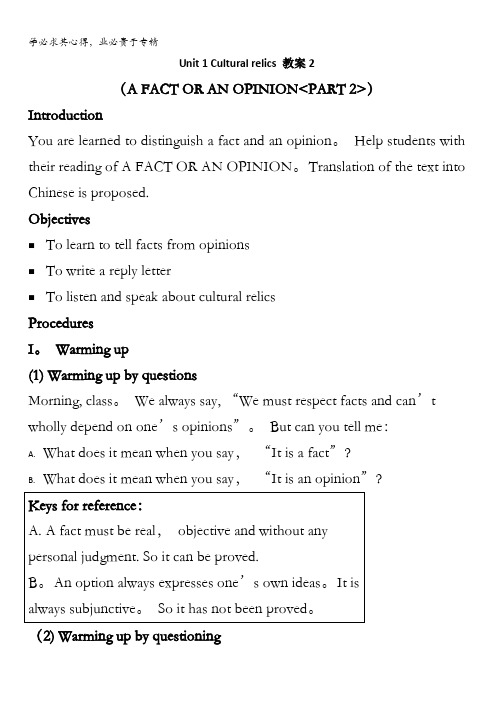
Unit 1 Cultural relics 教案2(A FACT OR AN OPINION<PART 2>)IntroductionYou are learned to distinguish a fact and an opinion。
Help students with their reading of A FACT OR AN OPINION。
Translation of the text into Chinese is proposed.Objectives⏹To learn to tell facts from opinions⏹To write a reply letter⏹To listen and speak about cultural relicsProceduresI。
Warming up(1) Warming up by questionsMorning, class。
We always say, “We must respect facts and can’t wholly depend on one’s opinions”。
But can you tell me:A.What does it mean when you say,“I t is a fact”?B.What does it mean when you say,“I t is an opinion”?(2) Warming up by questioningTurn to page 5。
Read the passage and tell me:A。
If you want to go in for law against somebody, and if you want to win,what’s the most important thing you should do first?B. What makes a judge decide which eyewitnesses to believe and which not to believe?II. Guided reading(1)Reading and definingRead the passage and define: What is a fact?What is an opinion?What is an evidence?(2)Reading and translatingRead the passage and translate it into Chinese paragraph by paragraph。
高中英语必修二教案

高中英语必修二教案【篇一:人教新课标高一英语必修2_unit_1教案】unit 1cultural relicsi. 单元教学目标ii. 目标语言ii. 教材分析与教材重组1. 教材分析本单元以cultural relics为话题,旨在通过单元教学使学生了解世界文化遗产,学会描述它们的起源,发展和保护等方面的情况,复习并掌握定语从句,能就如何保护和处理世界文化遗产给出自己的观点。
1.1 warming up 热身部分提供了四幅图片,设计了三个问题让学生交流对于cultural relic的了解,并就此进行讨论。
这部分的目的是呈现本单元的中心话题“文化遗产”。
1.2 pre-reading 是reading的热身部分,提供了ambers的图片并就此此设计了两个问题。
这两个问题极易引起学生对amber的兴趣,并能引导学生对课文进行prediction。
1.3 reading是关于寻找丢失了的普鲁士国王威廉一世送给俄罗斯沙皇的那个琥珀房子的建立、转让、被毁、重建的整个历史。
设计这篇文章的目的是让学生了解什么是文化遗产以及讨论保护和重建文化从文化遗产的重要性和必要性。
1.4 comprehending既有知识性的问题,同时又跳出了课文,对文章进行整体评价,由易到难,有较好的梯度,全面考查学生对文章的理解。
exercise 1将人物及相关事件匹配,检验学生对文章细节的理解;exercise 2 将所给的问题与段落匹配,是段落大意理解题;exercise 3安排了对于重建lost cultural relics的意义进行讨论,使得学生能对本单元的主题进行较为深入的探讨。
1.5 learning about language 分discovering useful words and expressions 和discovering useful structures两部分。
其中第一部分的exercise 1着重训练对英语单词解释的理解。
人教版高一英语必修二unit 1 reading教案
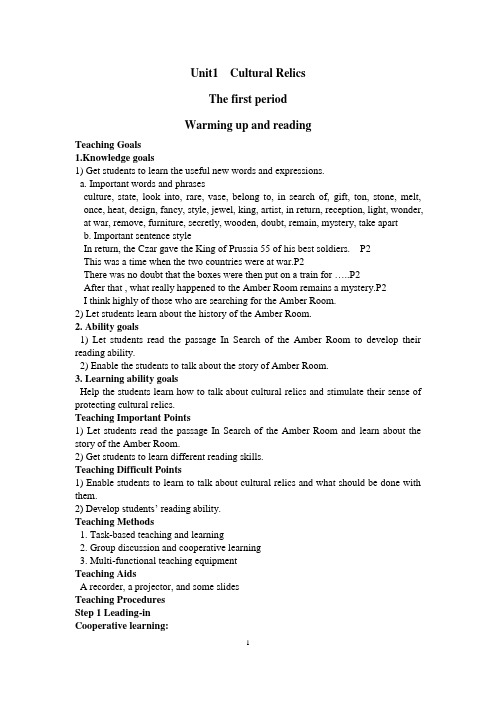
Unit1 Cultural RelicsThe first periodWarming up and readingTeaching Goals1.Knowledge goals1) Get students to learn the useful new words and expressions.a. Important words and phrasesculture, state, look into, rare, vase, belong to, in search of, gift, ton, stone, melt, once, heat, design, fancy, style, jewel, king, artist, in return, reception, light, wonder, at war, remove, furniture, secretly, wooden, doubt, remain, mystery, take apartb. Important sentence styleIn return, the Czar gave the King of Prussia 55 of his best soldiers. P2This was a time when the two countries were at war.P2There was no doubt that the boxes were then put on a train for …..P2After that , what really happened to the Amber Room remains a mystery.P2I think highly of those who are searching for the Amber Room.2) Let students learn about the history of the Amber Room.2. Ability goals1) Let students read the passage In Search of the Amber Room to develop their reading ability.2) Enable the students to talk about the story of Amber Room.3. Learning ability goalsHelp the students learn how to talk about cultural relics and stimulate their sense of protecting cultural relics.Teaching Important Points1) Let students read the passage In Search of the Amber Room and learn about the story of the Amber Room.2) Get students to learn different reading skills.Teaching Difficult Points1) Enable students to learn to talk about cultural relics and what should be done with them.2) Develop students’ reading ability.Teaching Methods1. Task-based teaching and learning2. Group discussion and cooperative learning3. Multi-functional teaching equipmentTeaching AidsA recorder, a projector, and some slidesTeaching ProceduresStep 1 Leading-inCooperative learning:1.Do you know these famous places? If you know, what do you know aboutthem?2.Which one do you like to visit? Why?3.What makes a city great and famous?(a long history; cultural relics; many great people; important events taking place there)4. In your opinion, what are cultural relics?2. Show some pictures of some famous cultural relics.(1) The Great Wall (2)The Pyramids in Egypt(3)The Tai Mahal (In India (4) The Sydney Opera (In Australia) (5) The Great Barrier Reef (In Australia) (6)The Big Ben (In England)Step 2 Pre-reading1. Ask students to predict what the passage is about according to the title and the picture.2. Suppose one of them got lost, how would you feel and what will you do with it? (Try our best to find it; Protect the others in order that they will not get lost; Rebuild a new one if we really can’t find it)Step 3 ReadingTask 1: Fast reading1.Answer the following questions:1)Why is it called the Amber Room?(It was given the name because almost seven thousand tons of amber were used to make it)2) What happened to the Amber Room?(The Amber Room was given to the Russian people as a great gift by the king)2. Skim the text and complete the exercises of Comprehending.①Keys to Ex11. The king of Prussia who gave the Amber Room as a gift to Russia was_______.A.Frederick IB. Frederick William IC. Peter the GreatD. Catherine II2. The king of Prussia gave the Amber Room to Russia because_____.A.he wanted to marry Catherine II.B. he was kind.C. he needed better soldiersD. he wanted to make friends3. The Amber Room was stolen by______.A.Russian soldiersB. German soldiersC. People in KonigsbergD. People in St Petersburg4. In 1941, the city of Konigsberg was in ___.A.GermanyB. RussiaC. SwedenD. France5. The Russians didn’t hide the Amber Room because ______.A.they were at warB. the couldn’t find a placeC. the German soldiers arrived too soonD. no train could take it awayT or F questions:( ) 1. The Amber Room was not easy to make.( ) 2. Catherine II didn’t like everythi ng about the Amber Room when she first saw it.( ) 3. The Amber Room was taken to Konigsberg and hidden there in 1941. ( ) 4. The Russians didn’t care about the Amber Room.( ) 5. The Russians don’t think the Amber Room will ever be found.Task 3: Intensive reading Main idea of each paragraphNow please read the text again and try to catch the main idea of each paragraph. After about five minutes reading, have some students speak for their teams.1st paragraph: the introduction of the Amber Room(The Amber Room had a strange history and something about its design, color, shape and material.)2nd paragraph: the gift to the Czar(the history of the Amber Room and its use in Russia—the Czar’s winter palace and a small reception hall for important visitors.)3rd paragraph: the relocation of the Amber Room in CatherineⅡ time (CatherineⅡ had the Amber Room moved to the palace outside St Petersburg told the artists to add more details to it.)4th paragraph: the missing of the Amber Room(the German Nazi stole the Amber Room secretly during the World WarⅡ,and what really happen to the Amber Room remain a mystery)5th paragraph: the rebuilding of the Amber Room(Russia and Germany have built a new Amber Room for the 300th birthday f St Petersburg.)Step 4 Discussion1. Do you think if it is worthwhile to reproduce the amber room? Why?2.What should we do to protect our cultural relics?Step 5 ConsolidationGive students some key words and expressions on the blackboard and let them retell the story.Step 6 Homework1. Learn the useful new words and expressions by heart.2. Read the text again and underline some different word and sentence structures for them.。
新人教必修二 unit 1 Reading for Writing教案

反思
成效
困惑
(信息技术应用)
SeewoWhiteboard5
教 学 过 程
备注
Step 1 Leading in
·Ask the students to enjoy a short video about the Mogao Caves, Dunhuang.
Step 2 Predicting
新人教高一英语 教案
Step 5 Getting ready for writing anews report
·Group students to read through theinterview notes in Activity 3-1 onpage 9 and try to figure out the factsand details of the person or the group.
教 学 过 程
备注
·Ask students toread the title andlook at the picture to predict what thenew's report is about.
·Invite some studentsto present theiranswers.
Step 3 Reading for general information
e similar structures and language to write a news report addressing theprotection of culturalheritage;
3.express their opinions accurately in a news report;
·Invite some pairs to present theiranswers through the projector tocheck the answers with the wholeclass.
新人教版高中英语必修2Unit1 Cultural relics教案2
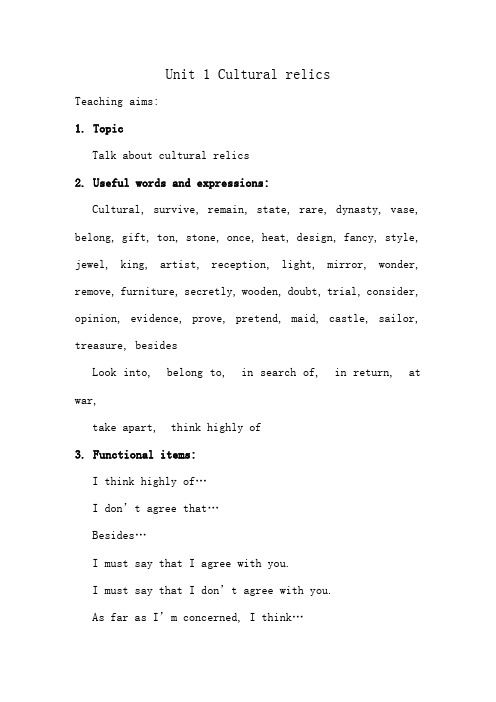
Unit 1 Cultural relicsTeaching aims:1. TopicTalk about cultural relics2. Useful words and expressions:Cultural, survive, remain, state, rare, dynasty, vase, belong, gift, ton, stone, once, heat, design, fancy, style, jewel, king, artist, reception, light, mirror, wonder, remove, furniture, secretly, wooden, doubt, trial, consider, opinion, evidence, prove, pretend, maid, castle, sailor, treasure, besidesLook into, belong to, in search of, in return, at war,take apart, think highly of3. Functional items:I think highly of…I don’t agree that…Besides…I must say that I agree with you.I must say that I don’t agree with you.As far as I’m concerned, I think…As I see it…Don’t you agree /think that…I can’t help thinking that…I would like to say…In my opinion/view…Personally, we should…Well, obviously we should…The point is ….4. StructuresThe attributive clause with that/ which /who /where/ whenA cultural relic is something that has survived…It is your job to look into any reports of cultural relics that have been found in China.This gift was the Amber Room, which was given this name because…Later, Catherine II had the Amber Room …outside St Petersburg where…This was a time when the two countries were at war. Teaching proceduresPeriod 1 (Reading)Step 1. Warming upThe warming-up exercise raises Ss’ awareness that there are some well-known cultural relics both at home and abroad. Ask the Ss to try their best to think of the cultural relics that they know.1. Ss say what they know about cultural relics.2. Teacher may summarize like this:Cultural relics are traces or features surviving from a past age and serving to remind people of them. They represent the culture of a place and some periods of history. Of course, some of them are in danger because they are being destroyed.3. Ask the Ss to give some examples of the cultural relics that are in the need of being protected.Step 2. Pre-reading1. Ss discuss and answer:How would you feel if a cultural relic got lost? Why?If you find a cultural relic, what will you do with it?2. Ss look at the two pictures on page 1-2. Ask them if they know what it is called.Step 3. While-reading1. Ss read and find the answers to the following questions:1)Why is it called the Amber Room?2)What happened to the Amber Room?2. Second reading: Ss read again and finish comprehending.3. Listening: Ss listen to the passage and get the main idea of each paragraph.Main idea:Paragraph 1. We can know that the Amber Room has a strange history and know something about its design and building. Paragraph 2. We can know the history of the Amber room and its functions in Russia.Paragraph 3. It tells us that Catherine II had the Amber Room moved to the palace outside St Petersburg.Paragraph 4. It tells us that the Nazi German army stole the Amber Room in September, 1941. After that the Amber Room remains a mystery.Paragraph 5. It tells us that the Russians and Germans have built a new Amber Room at the summer palace, following the old photos.Step 4. After-reading1. Ss discuss and answer: what they can do to protect our cultural relics.2. DebatingSs divided into two parts and debate.Topic: We should rebuild Yuan Mingyuan.We should not rebuild Yuan Mingyuan.Homework1. Recite the key sentences in the text.2. Retell the text.Period 2.(Language learning and grammar)Step 1. RevisionSs try to retell the text, using their own words.Step 2. Language points1. insist that2. 情态动词+ have done3. be made into4. be at war5. remain6. think highly ofStep 3 Discovering useful words and expressions1. Ss read the passage again and try to find word which means each of the meaning on page3,part 1.2. Teach the Ss how to use the dictionary to learn the usageof the phrase: belong to.Step 4. Grammar: The attributive clause1. Ss read the following sentences and try to find the rules.1)It is your job to look into any reports of cultural relics that have been found in China.2) This gift was the Amber Room, which was given this name because…Ask the Ss themselves to find the difference between the two sentences.3. Tell Ss the differences between restrictive attributive clause and non- restrictive attributive clause. Step 5. PracticeSs finish exercises 2 and 3 on page 4.Homework1. Ss finish Wb exercise: using works and expressions.2. Ss finish Wb exercise: using structures.3. Ss collect some information of the cultural relics that are in danger.Period 3. SpeakingStep 1. Revision1. Check Ss’ homework.2. Ask the Ss to say something about what they have collect about the cultural relics that are in danger.Step 2. Lead-in1. Ss watch videos about the world cultural relics.2. Ss find some cultural relics that are in danger and discuss what they will do with them.Step 3. Speaking taskT: China has tens of thousands of cultural relics. Perhaps it is not possible or necessary to save all of them. For example, Bejing is famous for its lanes or traditional houses and yards. Some people say that only the best ones should be saved. Others disagree, and say they make the capital a special place. Now, let’s have a discussion about this in two sides:Do you think China should save all of its cultural relics? Step 4. WritingAsk the Ss to write an article of 100-200 words about the whole discussion and express your opinion at the same time. Homework1. Review the attributive clauses.2. Remember the sentences that express one’s idea. Period 4. ReadingStep 1. Pre-readingT: since cultural relics are important and useful, it’s necessary for everyone to protect them. After all, they belong to the whole world. so today, we’ll read a passage that is about a common person who saves the cultural relics—Big Feng to the rescue. Read the passage for the first time and answer why Big Feng wants to save cultural relics. Step 2. Reading (P44)1. Ss read the passage again and answer the following questions:1). How does he save the cultural relics of his hometown?2). What does “a big heart”mean? In which ways does Feng Jicai show that he has a big heart?3). Why does he think it is more important to do this than to write his novels?4). It is very time-consuming and expensive for Feng Jicai to take care of cultural relics. Can you think of some other ways to help him with his projects?Step 3. Reading, listening and writing1. Ss read the passage on page 5.2. Play the tape. Ss listen to what three people say they know about the missing Amber Room. As they listen, pretend that they are judges.3. Ss listen again and take notes. Then fill in the forms on page 5. decide which of the three people they think gave the best evidence.Step 4. speaking and writing1. Discuss which person gave the vest evidence. Use the following expressions:Are you sure he/ she was telling the truth? How do you know that?How can you be sure he/ she was telling the truth?Why/why not?That can’t be true.I (don’t) believe …, because….I (don’t ) agree that…The truth is (not) easy to know.I can be proved.2. write down a short list of reasons for your choice. Period 5. ListeningStep 1. DictationT: we will have a dictation of the following sentences:1. Frederick William I, the king of Prussia could never nave imagined that his greatest gift to the Russian People would have such a strange history.2. Once it is heated, the amber can be made into any shape.3. It was made for the palace of Frederick.4. In 1716, Frederick William I gave it to Peter the Great, as a gift of friendship from the Prussian to the Russian People.5. In return, the Czar gave the King of Prussia 55 of his best soldiers.6. The Amber Room soon became part of the Czar’s Palace in St. Petersburg.7. Later, Catherine II had the Amber Room moved to the palace outside St Petersburg where she spent her summers.8. This was a time when the two countries were at war.9. There is no doubt that the boxes were then put on a train for Konigsberg, at that time a German city on the Baltic Sea.10. After that, what really happened to the Amber Room remains a mystery.11. I think highly of those who are searching for the Amber Room.Step 2. Listening (P41)1. Listen to the tape for the first time to get the main idea.2. Ss listen again and talks about a temple in Egypt, and then answer the questions on page 41.Step 3. Listening task (P44)Ss listen to the tape three times. At first time, try to get the main idea. At second time, try to spell the missing words as you hear them. At the last time, make some notes about I M Pei’s life. After listening, work in pairs. Each pair writes a short dialogue according to the notes.Period 6. WritingStep 1. Pre-writing1. Ask the Ss to read Johann’s letter first.2. Ss choose their writing models.Step 2. While-writing1. Ss collect their ideas for the letter. Write them down in order.2. Ss begin to write their letters.3. Choose some letters to show in the class.Step 3. Writing task (P46-47)1. Ss choose one cultural relic in their hometown that they think is worth saving. Write a letter to all the students of their school to encourage them to help save the cultural relic. They can use the model on page 46 as a guide.2. Ss check the answers each other.3. T checks the answers in class.Step 4. Project (P47)Ss finish the project as the following steps:1. Get together with three of your classmates and share your letters from the writing task with one another. Read each letter aloud.2. Know take the best ideas from each letter and make an even better plan to protect a cultural relic in your hometown. Explain your reasons.3. Organize your plan step by step to get more and more students to join the project.4. Prepare a short speech and have one member of your group tell you r classmates so that we can protect it well. Period sevenTeachers can use this period freely.Suggestion: Teachers can use this period to let Ss sum up what they have learned and explain what Ss couldn’t understand very well in this unit. Teachers can also add more practice in this period to consolidate what the Ss have learned. Finally, ask the Ss to finish checking yourself. It is very important to improve their learning.。
新人教版高一英语必修二unit1教案

or a cultural relic is something rather rare (while showing these photos, teach the new words in red: cultural relics, survive, remain, rare) 1. Get the students understand the iden ty of the cultural relics. 2. Let the students try to know that they are at least two sites of cultural relics, the natural site; and the cultural site. ( By showing the pictures of some natural sites relics. Eg: Mount Huashan, The JiuZhaiGou Valley, River Li ) Step Two: Drills Let the students make some more examples of cultural relics, including the ones inside our country or in other countries, especially the ones in our loca on. Here are some possible answers from the students: (The Neiguan Cave(内莞岩); The Xinfengjiang River(新丰江); Heyuan Dinosaur Park(河源恐龙公 园); Yuanmingyuan( 圆明园), etc.) (The Sydney Opera; The White House; The Big Ben; The Amber Room, etc.) Step Three: Discussing 1 As we all know that cultural relics are rather valuable, rare, and some mes, it is in very high price. 1. Then can you tell the value of the cultural relic? (Have the students discussed for some me in teams, then get their answers by expressing in class.) (There will be a lot of possible answers. Eg: From the cultural relics we can know what people did in the past, and we can know the cultures at that me, and maybe we can know the technology
高中英语人教版必修二unit1说课教案

1)The mancame here just now is my father.
2)Is this the manyou just talked to?
3)This is the shopsells medicine.
4)The filmwe saw yesterday is interesting.
2)Let students clearly know the differences betweenthe Restrictive and Non-Restrictive Attributive Clause.
3)Make students understand the distinctions between the relative“as”and“which”inNon-Restrictive Attributive Clause.
f)In 1770, the room was completed the way she wanted it.
g)This was a time when the two countries were at war.
h)There is no doubt that the boxeswerethen put on a train for Konigsberg, which was at that time a German city on the Baltic Sea.
d)However, the nextKing of Prussia, Frederick William1, to whom the amber roombelonged, decided not to keep it.
e)Later, CatherineⅡhad the Amber Room moved to the palace outside St Petersburg where she spent her summers.
人教版英语必修二Unit 1 reading 教案

让学生看懂文章,该文章是叙述类文体,要帮助学生理清文章线索,来龙去脉,了解有关琥珀屋的故事。掌握课文中出现的新课标要求的重点词汇和重点句型。培养学生概括文章段落大意的能力,理清文章篇章结构。培养学生根据课文标题猜测,预测课文内容的能力,促进有效阅读。树立文化遗产保护的意识。
教学重点和难点
帮助学生理解文段有关琥珀屋历史的来龙去脉,人物关系。理解文章结构和细节。熟悉文章内容,琥珀屋的历史。文章中出现的重点词汇短语,句型,语法知识点。
见图片
The making of the amber room
Thegivingof the amber room
The changingof the amber room
Thelosingof the amber room
Therebuildingof the amber room
学生学习活动评价设计
让学生首先对琥珀屋有一个感性的了解什么是琥珀什么是琥珀屋
教学环节
教师活动
预设学生行为
设计意图
第一步导入
第二步快速阅读
第三步仔细阅读
第四步读后活动summary
向全班学生提问have you ever seen a piece of amber?
向学生展示几张琥珀的图片,请学生根据图片概括出琥珀的外形特点。
学生基本都能参与进来,阅读活动任务循序渐进,活动方式多样,比较容易吸引学生兴趣。但是有些还是有一定难度。教学设计没有很好的考虑时间分配。整堂课下来,学生应该对琥珀屋的历史有所了解,也理清文章结构
教学反思
教学设计没有很好的考虑时间分配。内容没有有所侧重。重难点不突出。没有以学生为主体,进行有效的互动,合作学习策略在本堂课体现较少。
人教课标版高中英语必修2 Unit1_语言点课名师教学设计
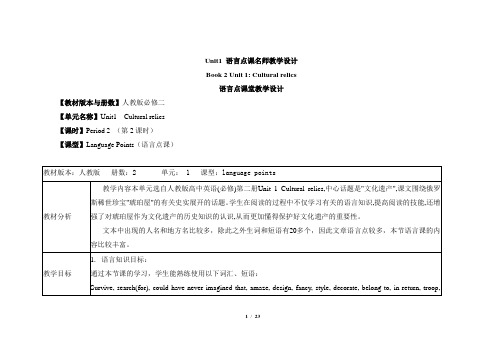
2. the problems of language points in the text of In search of the Amber Room;
3. any other problems of language points relevant to the text.
文本中出现的人名和地方名比较多,除此之外生词和短语有20多个,因此文章语言点较多,本节语言课的内容比较丰富。
教学目标
1.语言知识目标:
通过本节课的学习,学生能熟练使用以下词汇、短语:
Survive, search(for), could have never imagined that, amaze,design, fancy, style, decorate, belong to, in return, troop, serveas, have sth done, add, the way she wanted, light, consider, wonder, remove, there is no doubt, at war, less than, remain, former, worth
amazed adj感到惊奇的
amazing adj令人吃惊的
amazement n惊奇
amazingly adv令人惊奇的是
amaze sb使某人惊奇
It amazed me to hear that you were leaving.
be amazed at/by对----大为惊奇
We were amazed at his rapid recovery.
S: ...
人教版高中英语必修二unit-1-词汇课教案
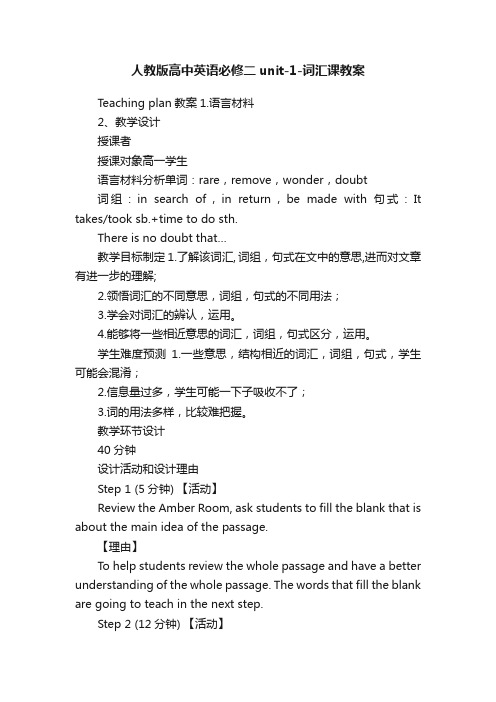
人教版高中英语必修二unit-1-词汇课教案Teaching plan教案1.语言材料2、教学设计授课者授课对象高一学生语言材料分析单词:rare,remove,wonder,doubt词组:in search of,in return,be made with 句式:It takes/took sb.+time to do sth.There is no doubt that…教学目标制定1.了解该词汇, 词组,句式在文中的意思,进而对文章有进一步的理解;2.领悟词汇的不同意思,词组,句式的不同用法;3.学会对词汇的辨认,运用。
4.能够将一些相近意思的词汇,词组,句式区分,运用。
学生难度预测1.一些意思,结构相近的词汇,词组,句式,学生可能会混淆;2.信息量过多,学生可能一下子吸收不了;3.词的用法多样,比较难把握。
教学环节设计40分钟设计活动和设计理由Step 1 (5分钟) 【活动】Review the Amber Room, ask students to fill the blank that is about the main idea of the passage.【理由】To help students review the whole passage and have a better understanding of the whole passage. The words that fill the blank are going to teach in the next step.Step 2 (12分钟) 【活动】1.Show some relative pictures to introduce the word ;2.Explain some important usage of the word;3.Show other pictures and ask students to describe the pictures with the wordjust learn, or give some multiple choice exercise, or translation, or askstudents to do some matching..【理由】/doc/fa17844806.html,ing pictures can let students feel interesting and help them understand the word;2.Help students understand the word well and tell the important usage ;人教版高中英语必修2 Unit 1 Page1~2 词汇课3.Different exercise can help students to use the words correctly.Step 3 (12分钟) 【活动】1.Show the original sentences of the passage that involve the phrase;2.Show other sentences that involve the same phrase and help students to find out theusage and meaning of the phrase;/doc/fa17844806.html,pare the phrase with other phrases that have the similar meaning or usage and help students to distinguish them;4.Some exercise that help students to use the phrases.【理由】1.Teach students how to guess the meaning of new phrases;2.Help them remember these phrases and their usage;3.Help students to distinguish some similar phrases;4.Help them be able to use these phrases and use them correctly.Step 4 (6分钟) 【活动】1.Show the original sentences of the text and show other sentences that have the samepattern as the original sentences;2.Guide students find out the sentences’ pattern;3.Explain the usage of the sentences’ pattern;4.Ask students to make up some sentences with the sentences pattern and do sometranslation.【理由】1.Help students find out the sentences’pattern by themselves;2.Teach students how to use those sentences’ pattern correctly.Step 5 (5min) 【活动】1. Review the words and phrase;2. Emphasize some important words or phrases that students may still not understand well and ask students to review them after class;2. Assign the work after class;【理由】1.Help students to remember the new knowledge;2.Help students to review the new knowledge;3.Remind students to review the new knowledge.上一页下一页。
人教版高中英语必修2新 Unit1 Cultural relics教案
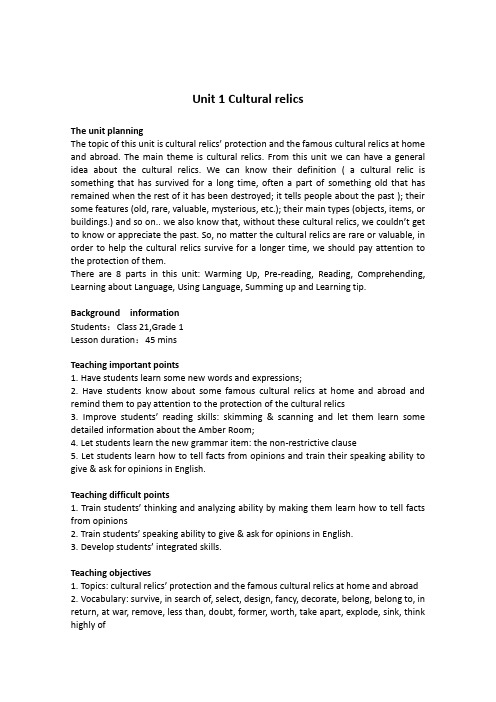
Unit 1 Cultural relicsThe unit planningThe topic of this unit is cultural relics’ protection and the famous cultural relics at home and abroad. The main theme is cultural relics. From this unit we can have a general idea about the cultural relics. We can know their definition ( a cultural relic is something that has survived for a long time, often a part of something old that has remained when the rest of it has been destroyed; it tells people about the past ); their some features (old, rare, valuable, mysterious, etc.); their main types (objects, items, or buildings.) and so on.. we also kn ow that, without these cultural relics, we couldn’t get to know or appreciate the past. So, no matter the cultural relics are rare or valuable, in order to help the cultural relics survive for a longer time, we should pay attention to the protection of them.There are 8 parts in this unit: Warming Up, Pre-reading, Reading, Comprehending, Learning about Language, Using Language, Summing up and Learning tip. Background informationStudents:Class 21,Grade 1Lesson duration:45 minsTeaching important points1. Have students learn some new words and expressions;2. Have students know about some famous cultural relics at home and abroad and remind them to pay attention to the protection of the cultural relics3. Improve students’ reading skills: skimming & scanning and let them learn some detailed information about the Amber Room;4. Let students learn the new grammar item: the non-restrictive clause5. Let students learn how to tell facts from opinions and train their speaking ability to give & ask for opinions in English.Teaching difficult points1. Train students’ thinking and analyzing ability by making them learn how to tell facts from opinions2. Train students’ speaking ability to give & ask for opinions in English.3. Develop students’ integrated skills.Teaching objectives1. Topics: cultural relics’ protection and the famous cultural relics at home and abroad2. Vocabulary: survive, in search of, select, design, fancy, decorate, belong, belong to, in return, at war, remove, less than, doubt, former, worth, take apart, explode, sink, think highly of3. Functions:1.) Asking for opinionsWhat do you think of...?Do you believe...?How can you be sure of...?How do you know that?2.) Giving opinionsI think...I don't think...I don't agree that...I suppose that...4. Grammar: the attributive clause1.) the restrictive clauseThis was a time when the two countries were at war.2.) the non-restrictive attributive clauseThis gift was the Amber Room, which was given this name because several tons of amber were used to make it.Teaching Methods1. Audio-lingual Method2. Communicative Approach3. Pair work4. Group workTeaching Aids1. Multi-media2. Pictures3. Music4. Video课时安排The first period: Warming Up, Pre-reading,The second period: Reading, Comprehending,The third and fourth period: Learning about LanguageThe fifth period: Discovering Useful structuresThe sixth period: Using LanguageThe first period:Warming Up, Pre-readingKnowledge:1.) some new words:cultural relics, rare, valuable, vase, dynasty, survive2.) Have students know about some famous cultural relics at home and abroad. Ability:Help students learn how to talk about cultural relicsEmotion:Encourage students to pay attention to the protection of the cultural relics. Teaching important pointsHave students know about some famous cultural relics at home and abroad and remind them to pay attention to the protection of the cultural relicsTeaching difficult points:How to talk about cultural relics.Teaching methods1. Audio-lingual Method2. Communicative Approach3. Pair workTeaching Aids1. Multi-media2. Pictures3. Music4. VideoProcedures:Step1. Lead-inShow the pictures: a one yuan coin & the old coinsLet students talk about the differences between the one yuan coin and the old coins from many aspects like shape, time, price, etc.So, what we will talk about today: they are also old but more expensive & more significant. They are the cultural relicsStep2. Warming up1. "Let's travel together!" Show some pictures about cultural relics at home and abroad.1.) Go abroad:a. the pyramids in Egyptb. the Big Ben in England2.) In Chinaa.周口店北京猿人遗址b.播放一段音乐:说唱脸谱--- 京剧(非物质文化遗产)在今年11月刚申遗成功的另一项目:活字印刷术播放当天新闻,他被列为2010急需保护的非物质文化遗产,所以提醒大家注意对文化遗产的保护。
必修二unit1教案
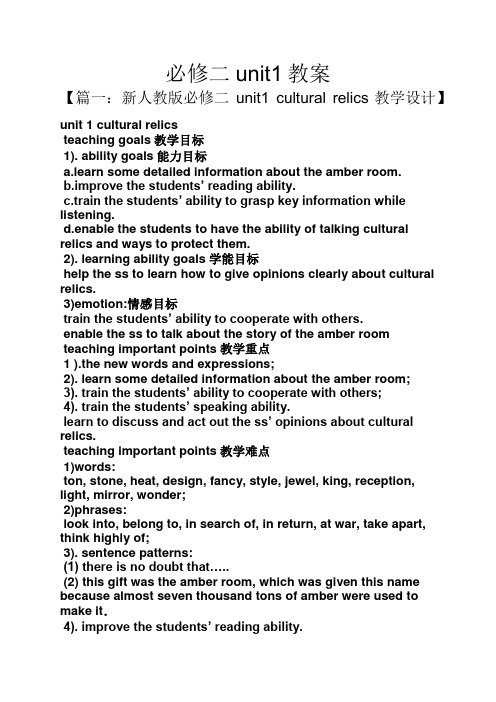
必修二unit1教案【篇一:新人教版必修二unit1 cultural relics教学设计】unit 1 cultural relicsteaching goals教学目标1). ability goals能力目标a.learn some detailed information about the amber room.b.improve the students’ reading ability.c.train the students’ ability to grasp key information while listening.d.enable the students to have the ability of talking culturalrelics and ways to protect them.2). learning ability goals学能目标help the ss to learn how to give opinions clearly about cultural relics.3)emotion:情感目标train the students’ ability to cooperate with others.enable the ss to talk about the story of the amber roomteaching important points教学重点1 ).the new words and expressions;2). learn some detailed information about the amber room;3). train the students’ ability to cooperate with others;4). train the students’ speaking ability.learn to discuss and act out the ss’ opinions about cultural relics.teaching important points教学难点1)words:ton, stone, heat, design, fancy, style, jewel, king, reception, light, mirror, wonder;2)phrases:look into, belong to, in search of, in return, at war, take apart, think highly of;3). sentence patterns:(1) there is no doubt that…..(2) this gift was the amber room, which was given this name because almost seven thousand tons of amber were used to make it.4). improve the students’ reading ability.train the students’ ability to grasp key information while listening.how to teach the students to speak out their opinions about cultural relics. teaching methods教学方法1). watch some videos about the cultural relics. (individuals)2). have a discussion. (group work)3). write an article about the discussion. (individuals)teaching aids教学设备a computer, a projector and some slides.teaching procedures and ways教学过程与方式the first second period (vocabulary,warming up andpre-reading)teaching goals:1. target languagecultural, survive, remain, state, rare, dynasty, vase, belong to 2. learning ability goalshelp the students learn how to talk about cultural relics and have the sense of protecting cultural relics.teaching important pointstalk about cultural relics and what should be done with them.teaching difficult points:how to talk about cultural relics.teaching methods:group discussion and presentation.(cooperative learning)the first second periodteaching procedures:step 1 new words teachingstep 2 warming-upt: when talking about cultural relics, what comes to your mind? s1: the great wall.s2: the pyramids in egypt.s3: …t: well done.teacher asks the ss to look at the three groups of pictures and discuss these questions.1. do you know these places?2. if you know, what do you know about the places?3. which one would you like to visit? why?i: as is known to all, china is a country with a history of more than 5,000 years. in the long history, people in differentperiods have left us quite a number of cultural sites, many of which are world famous. now look at the pictures and guess what heritage they are.all these are cultural relics.do you know any other cultural relics in the world?t shows the ss some cultural relics abroad.task 1: ask the ss to make a dialogue by saying.imagine you have a chance to travel these places. which place would you like to go? why? when are you starting off? how are you getting there? how long are you staying?please make a dialogue with your partners. then students answer the following questions:what is your favorite city? why?what makes a city great and famous?(a long history; cultural relics; many great people; important events taking placethere)t:unfortunately, some of them are in danger because they are destroyed, and some of them were lost because someone stole them.task 2: now suppose that you work for the state office of cultural relics. you are sent to a small town where you find a relic that was stolen from a palace. it is a rare ming dynasty vase. the man who has it insists that it belongs to his family. what will you say to him?work in pairs to discuss this question, and then i’ll ask some ss to tell me your answers.step 3 task 3 speaking task on page 46debate do you think china should save all of its cultural relics? do you think it necessary to rebuild yuanmingyuan in beijing? t: after watching so many pictures, now discuss with your partners the following question:what is a cultural relics?(ss can find the answer from the warming up.)step 4 pre-readingt: ok, class, do you think these cultural relics are beautiful?ss: yes, very beautiful.t: suppose one of them got lost, how would you feel and what will you do with it? s1: try our best to find it.s2: protect the others in order that they will not lost. ……t: thanks for your good suggestions. if you find a cultural relic, what will you do with it? you can make a dialogue with your partner on this question.t can practice it with a student to give an example.extending questions: to whom do cultural relics belong?step 5 language points1) survivesurvive: vi. continue to live or exist.in alive after sb., live or exist longer thane.g: many strange customs have survived from earlier times.her parents died in the accident, but she survived.few buildings survived the earthquake.the man survived his sister by three years.2) (a) part ofa part of the books have arrived.a leg is a part of the body.he gave me back only part of the money i lent him.part of the house was burnt in the fire.part of the passengers were injured in the accident.*part of it _________ good.*part of them _____________ good.3) something通常用于肯定句,而在疑问句、否定句、if/weather从句中用anything。
人教版高一英语必修二教案《Unit 1 Cultural relice》
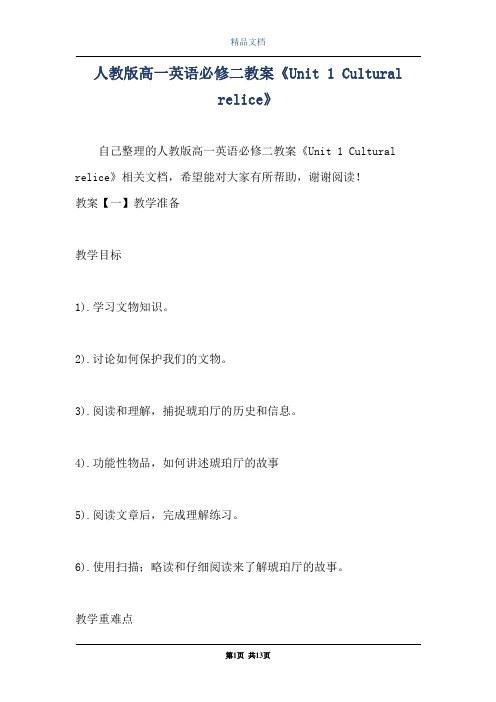
人教版高一英语必修二教案《Unit 1 Culturalrelice》自己整理的人教版高一英语必修二教案《Unit 1 Cultural relice》相关文档,希望能对大家有所帮助,谢谢阅读!教案【一】教学准备教学目标1).学习文物知识。
2).讨论如何保护我们的文物。
3).阅读和理解,捕捉琥珀厅的历史和信息。
4).功能性物品,如何讲述琥珀厅的故事5).阅读文章后,完成理解练习。
6).使用扫描;略读和仔细阅读来了解琥珀厅的故事。
教学重难点要点了解文物。
如何讲述琥珀厅的故事困难用英语自由谈论国内外文物。
学习琥珀厅的故事。
教学工具课件教学过程导入1).客人:老师出示一些图片和陈述,让学生猜猜它在哪里。
长城;金字塔;泰姬陵2)老师展示一些图片。
它们在中国或世界上都是非常著名的地方。
让学生思考这些:A.你能说出他们的名字吗?谁有权利拥有和确认它们?(如图:组1;圆明园;故宫组2:明代花瓶;泰姬陵;象牙龙舟和莫高窟)步骤I:预读1).好吧,你对文物有所了解,你见过一块琥珀吗?你知道些什么?展示一些琥珀的图片。
让学生知道琥珀是什么及其价值。
颜色黄棕色感觉像石头一样坚硬琥珀是化石(化石)树脂的形式(树脂)从树上。
它需要数百万年才能形成。
2).你能想象一个琥珀做的房子吗?请预览”寻找琥珀厅”阅读并思考标题:1).老师给学生下列问题进行思考看到这个标题,你想知道什么?琥珀厅是什么?为什么叫琥珀厅?它是做什么用的?它怎么了?为什么要搜索呢?(让学生记住这些问题,而不是找到答案。
)2).快速阅读以获得主要思想:《琥珀厅》是_____________作为_____送给俄罗斯人民的,是由____________士兵建造的。
(学生快速阅读文章并填写表格)3).现在,让学生试着回答第一部分的问题(PPT 7)(老师可能会给一些必要的帮助)步骤三:扫描让学生扫描课文中出现的所有人的名字,找出他们对琥珀厅做了什么。
把句子的正确部分连接在一起。
人教版高一英语必修二教案《Unit,1,Cultural,relice》
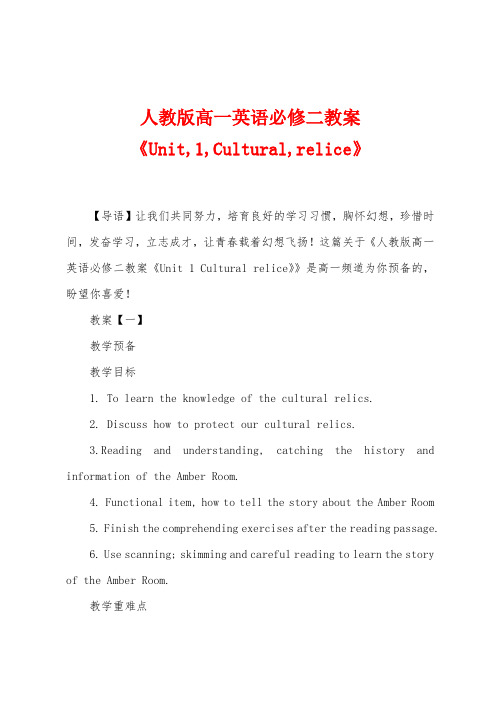
人教版高一英语必修二教案《Unit,1,Cultural,relice》【导语】让我们共同努力,培育良好的学习习惯,胸怀幻想,珍惜时间,发奋学习,立志成才,让青春载着幻想飞扬!这篇关于《人教版高一英语必修二教案《Unit 1 Cultural relice》》是高一频道为你预备的,盼望你喜爱!教案【一】教学预备教学目标1. To learn the knowledge of the cultural relics.2. Discuss how to protect our cultural relics.3.Reading and understanding, catching the history and information of the Amber Room.4. Functional item, how to tell the story about the Amber Room5. Finish the comprehending exercises after the reading passage.6. Use scanning; skimming and careful reading to learn the story of the Amber Room.教学重难点Key pointsTo understand cultural relics.How to tell the story about the Amber RoomDifficultiesTalk about cultural relics at home and abroad in English freely. To learn the story of the amber room.教学工具课件教学过程导入1. Guessing:Teacher present some pictures and statements ,let the students guess whtat or where it is.The Great Wall; The Pyramid ; Taj Mahal2Teacher show some pictures. They are all very famous places in China or in the world. Ask the students to think these over: A. Can you name them out?Who have the right to own and confirm them?The shown pictures: Group 1;①Yuanmingyuan; ②Forbidden City Group 2: ③Ming Dynasty vase ;④Taj Mahal; ⑤ivory dragon boatand Mogao CavesStep I: Pre-reading1.Ok, you have know something about cultural relics, have you ever seen a piece of amber?And what do you know about it?Show some pictures of amber. Let students know what the amber is and its value.color yellow- brownfeel like feel as hard as stoneAmber is the fossil化石 form of resin树脂 from trees.It takes millions of years to form.2. Can you imagine a house made of amber?Please preview “In search of the amber room.”Step II: Fsat reading and thinking about the title:1. Teacher give students the following questions to think: When you see this title, what do you want to know?What is the Amber Room?Why was it called the Amber Room?What was it made for?What happened to it?Why to search for it?Ask the students just remember these questions in their mind not find the answers.2. Fast reading to get the main idea:The Amber Room , which _________________sent to the Russian people as a _____, was ____by the _____________ soldiers .Students read the passage quickly and fill in the blans3. Now, let the students try to answer the questions in part 1. PPT 7Teacher may give some necessary helpStep III: ScanningAsk the students to scan all the names of the person appeared in the text and find out what did they do to the amber room. Join the correct parts of the sentences together. exercise 1 on page 2 After do the above exercise ,teacher give students a picture of the people in the text and let the students try to tell theclue of the story according to the persons. PPT 9Step IV: SkimmingAsk students to skim the passage and complete exercise 2 on page2.3 How did the Amber Room become one of the wonders of theworld?5 How was a new Amber Room built?4 How did the Amber Room get lost?1 How was the Amber Room made?2 Why did the King of Prussia give the Amber Room to the Czar of Russia as a gift?Step V: Careful readingLet the students read the text carefully and try to find some details to complete the form on PPT 11.Step VI: Role playJust now you have learnt the story of The Amber Room, now suppose you are a guide of The Amber Room, how will you intrduce the amber room to the visitors?Give students about 3 minutes to have a discussion in group of four ,then ask some of groups to make a role play before all the class.Homework1. Read the story of The Amber Room again after class.2. Write the introduction of the Amber Room you have discussed in class.3. Prepare for next period by underline the difficult points in the text.板书Blackboard DesignUnit 1 Cultural relicsWarming up & pre-readingWhat is cultural relics?A.a cultural relic is sth. that survived for a long timeB.a cultural relic may be a part of old thing has remained when the rest of it had been destroyedC. a cultural relic is something rather rare教案【二】教学预备教学目标Knowledge and ability: To help the Ss know about the history of the Amber room and develop their reading skills.Process and method: Ss acquire knowledge and improve ability through discussion and competition.Emotion, attitude and values: to arouse Ss“s awareness of protecting the cultural relics. Understand cultural relics belongto the whole world and the human beings.教学重难点important point: Understand the content of the whole passage and master the different reading skills,such as ,skimming, scanning and so on.difficult point : how to solve the questions and find the useful information using the reading skills.教学工具课件教学过程Lead in1. show some pictures .2. show the pictures and a short video of amber room.purpose: motive Ss“s interest.Hi, everyone. Let’s look at the screen. I’ll present you some pictures. They are all about cultural relics. Some of them are cultural sites. Some of them are natural sites. Only an international professional organization from UN has the right to decide on and name them.PresentationLook at the photos here. What do you know about the substance of “amber”? What do knowabout the cultural relics “the Amber Room”?discussion:Now, boys and girls, I met a “moral dilemma”. That means I must make a choice between the interests of the family and the interests of the society. Things are like this: My old granny happened to find an ancient vase under a tree in the earth of our garden. It’s so beautiful and special. Now, my family fell into a moral dilemma. Can you help us to make a decision?A: What should we do?B: Can we keep it for ourselves or report it to the government? C: Have you come across such a situation — to make a difficult choice?listen and answer the questions:Play tape. Ss get the main idea of the passage.Readingpre-reading:1. Have you ever seen a piece of amber?What do you know about it?2. look at the title and the picture. predict what it is about. Then skim it quickly and see if you were right.Reading:1st time:read by yourself as quickly as you can.join the correct parts of the sentences together.2nd time:choices and T/Fcompete between boys and girls.3rd time:answer some question. Ask ss to think over and discuss.purpose: understand the text better and arouse Ss“s awareness of competition. Grasp the main information.Discussion and reportThink over of what we discuss in the part of warming up: I find myself falling into the dilemma.you discuss together ,and write down the outline of a report. work in groupConsolidationfill in the blanks summary.Homeworkmake a report .use the useful information in the passage.。
高一英语必修二《Unit 1 Cultural relice》教案人教版范文2篇
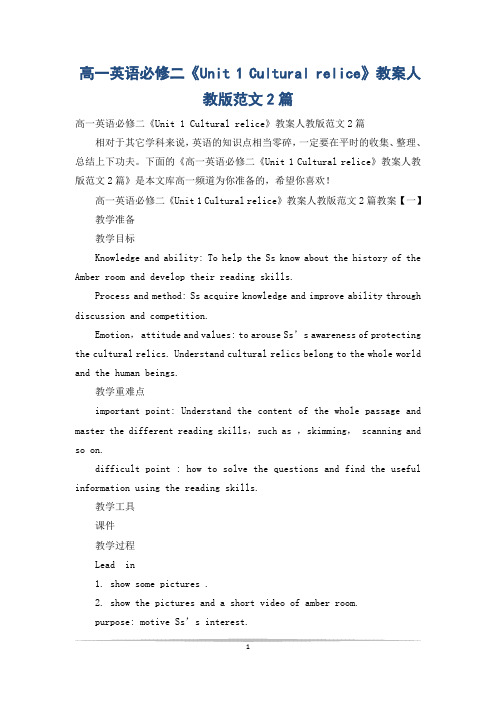
高一英语必修二《Unit 1 Cultural relice》教案人教版范文2篇高一英语必修二《Unit 1 Cultural relice》教案人教版范文2篇相对于其它学科来说,英语的知识点相当零碎,一定要在平时的收集、整理、总结上下功夫。
下面的《高一英语必修二《Unit 1 Cultural relice》教案人教版范文2篇》是本文库高一频道为你准备的,希望你喜欢!高一英语必修二《Unit 1 Cultural relice》教案人教版范文2篇教案【一】教学准备教学目标Knowledge and ability: To help the Ss know about the history of the Amber room and develop their reading skills.Process and method: Ss acquire knowledge and improve ability through discussion and competition.Emotion, attitude and values: to arouse Ss’s awareness of protecting the cultural relics. Understand cultural relics belong to the whole world and the human beings.教学重难点important point: Understand the content of the whole passage and master the different reading skills,such as ,skimming, scanning and so on.difficult point : how to solve the questions and find the useful information using the reading skills.教学工具课件教学过程Lead in1. show some pictures .2. show the pictures and a short video of amber room.purpose: motive Ss’s interest.Hi,everyone. Let’s look at the screen. I’ll present you some pictures. They are all about cultural relics. Some of them are cultural sites. Some of them are natural sites. Only an international professional organization from UN has the right to decide on and name them.PresentationLook at the photos here. What do you know about the substance of "amber" What do knowabout the cultural relics "the Amber Room"discussion:Now, boys and girls, I met a "moral dilemma". That means I must make a choice between the interests of the family and the interests of the society. Things are like this: My old granny happened to find an ancient vase under a tree in the earth of our ga rden. It’s so beautiful and special. Now, my family fell into a moral dilemma. Can you help us to make a decisionA: What should we doB: Can we keep it for ourselves or report it to the governmentC: Have you come across such a situation - to make a difficult choice listen and answer the questions:Play tape. Ss get the main idea of the passage.Readingpre-reading:1. Have you ever seen a piece of amberWhat do you know about it2. look at the title and the picture. predict what it is about. Then skim it quickly and see if you were right.Reading:1st time:read by yourself as quickly as you can.join the correct parts of the sentences together.2nd time:choices and T/Fcompete between boys and girls.3rd time:answer some question. Ask ss to think over and discuss.purpose: understand the text better and arouse Ss’s awareness of competition. Grasp the main information.Discussion and reportThink over of what we discuss in the part of warming up: I find myself falling into the dilemma.you discuss together ,and write down the outline of a report.work in groupConsolidationfill in the blanks (summary).Homeworkmake a report .use the useful information in the passage.高一英语必修二《Unit 1 Cultural relice》教案人教版范文2篇教案【二】教学准备教学目标1). To learn the knowledge of the cultural relics.2). Discuss how to protect our cultural relics.3).Reading and understanding, catching the history and information of the Amber Room.4). Functional item, how to tell the story about the Amber Room 5). Finish the comprehending exercises after the reading passage. 6). Use scanning; skimming and careful reading to learn the story of the Amber Room.教学重难点Key pointsTo understand cultural relics.How to tell the story about the Amber RoomDifficultiesTalk about cultural relics at home and abroad in English freely. To learn the story of the amber room.教学工具课件教学过程导入1). Guessing:Teacher present some pictures and statements ,let the students guess whtat or where it is.The Great Wall; The Pyramid ; Taj Mahal2)Teacher show some pictures. They are all very famous places in China or in the world. Ask the students to think these over:A. Can you name them outWho have the right to own and confirm them(The shown pictures: Group 1;①Yuanmingyuan;②Forbidden City Group 2: ③Ming Dynasty vase ;④Taj Mahal;⑤ivory dragon boat and Mogao Caves)Step I: Pre-reading1).Ok, you have know something about cultural relics, have you ever seen a piece of amberAnd what do you know about itShow some pictures of amber. Let students know what the amber is and its value.color yellow- brownfeel like feel as hard as stoneAmber is the fossil(化石) form of resin(树脂) from trees.It takes millions of years to form.2). Can you imagine a house made of amberPlease preview "In search of the amber room."Step II: Fsat reading and thinking about the title:1). Teacher give students the following questions to think:When you see this title, what do you want to knowWhat is the Amber RoomWhy was it called the Amber RoomWhat was it made forWhat happened to itWhy to search for it(Ask the students just remember these questions in their mind not find the answers.)2). Fast reading to get the main idea:The Amber Room , which _________________sent to the Russian people as a _____, was ____by the _____________ soldiers .(Students read the passage quickly and fill in the blans)3). Now, let the students try to answer the questions in part 1). (PPT 7)(Teacher may give some necessary help)Step III: ScanningAsk the students to scan all the names of the person appeared in the text and find out what did they do to the amber room. Join the correct parts of the sentences together. (exercise 1 on page 2)After do the above exercise ,teacher give students a picture of the people in the text and let the students try to tell theclue of the story according to the persons. (PPT 9)Step IV: SkimmingAsk students to skim the passage and complete exercise 2 on page2.( 3 ) How did the Amber Room become one of the wonders of the world ( 5 ) How was a new Amber Room built( 4 ) How did the Amber Room get lost( 1 ) How was the Amber Room made( 2 ) Why did the King of Prussia give the Amber Room to the Czar of Russia as a giftStep V: Careful readingLet the students read the text carefully and try to find some details to complete the form on PPT 11.Step VI: Role playJust now you have learnt the story of The Amber Room, now suppose you are a guide of The Amber Room, how will you intrduce the amber room to the visitors( Give students about 3 minutes to have a discussion in group of four ,then ask some of groups to make a role play before all the class.) Homework1. Read the story of The Amber Room again after class.2. Write the introduction of the Amber Room you have discussed in class.3. Prepare for next period by underline the difficult points in the text.板书Blackboard DesignUnit 1 Cultural relicsWarming up … pre-readingWhat is cultural relicsA.a cultural relic is sth. that survived for a long timeB.a cultural relic may be a part of old thing has remained when the rest of it had been destroyedC. a cultural relic is something rather rare。
人教版高中英语必修二unit1教案

人教版高中英语必修二unit1教案以下是一份人教版高中英语必修二unit1的教案模板,供您参考:一、教学目标1. 知识目标:掌握本单元的重点词汇和短语,如“access”,“available”,“click”,“database”等。
2. 能力目标:能够理解和运用本单元所学的词汇和语法结构,提高阅读和写作能力,并能够在实际生活中运用所学知识进行交流。
3. 情感目标:培养学生对科技发展的认识和兴趣,激发他们探索新技术的热情。
二、教学内容本单元主题是“科技发展”,主要介绍了互联网和人工智能的发展和应用。
通过本单元的学习,学生将了解互联网和人工智能的基本概念和发展历程,以及它们在各个领域的应用和影响。
三、教学重点与难点1. 教学重点:掌握本单元的重点词汇和短语,理解课文中的长句和难句。
2. 教学难点:理解课文中的抽象概念和深入思考科技发展的影响和利弊。
四、教具和多媒体资源1. 黑板:用于书写重点词汇和句型。
2. 投影仪:播放PPT和相关视频资料。
3. 教学软件:提供在线学习资源和互动练习。
五、教学方法1. 激活学生的前知:通过提问和讨论,了解学生对科技发展的已有认知。
2. 教学策略:采用讲解、示范、小组讨论、案例分析等多种教学方法,帮助学生理解和运用所学知识。
3. 学生活动:组织学生进行小组讨论、角色扮演等活动,提高他们的参与度和实践能力。
六、教学过程1. 导入(5分钟)通过提问导入新课:“你们平时上网都做什么?”引导学生回答,引出互联网的概念和应用。
再问:“你们知道互联网的发展历程吗?”引导学生思考,引出本单元的主题。
2. 呈现新知(15分钟)通过PPT展示互联网和人工智能的发展历程和应用领域,同时讲解课文中的重点词汇和语法结构。
在讲解过程中,引导学生关注课文中的长句和难句,帮助他们理解抽象概念。
3. 巩固练习(10分钟)提供相关练习题,如词汇翻译、句子改写等,帮助学生巩固所学知识。
同时组织学生进行小组讨论,探讨科技发展对生活和工作的影响和利弊。
- 1、下载文档前请自行甄别文档内容的完整性,平台不提供额外的编辑、内容补充、找答案等附加服务。
- 2、"仅部分预览"的文档,不可在线预览部分如存在完整性等问题,可反馈申请退款(可完整预览的文档不适用该条件!)。
- 3、如文档侵犯您的权益,请联系客服反馈,我们会尽快为您处理(人工客服工作时间:9:00-18:30)。
The First Period(Warming up, one class)Teaching Aims:1. To learn the knowledge of the cultural relics.2. Discuss how to protect our cultural relics.3. To learn the following words or phrases:Teaching DesignStep One: Presentation(By showing them some photos of some famous cultural relics.)Hello, everybody, let’s look at the screen. Here are some pictures. They are all very famous places in China or in the world. Please think these over:A.Can you name them out?B.Who have the right to own and confirm them?(The shown pictures:①The Great Wall, ②The Imperial Palace of the Ming and Qing Dynasties in Beijing and Shenyang; ③The Mausoleum of the First Qin Emperor and the Terracotta Warriors)Let the students name out the famous places in the pictures, and tell them they are cultural relic s. And explain what cultural relics are.A. a cultural relic is sth. that survive d for a long timeB. a cultural relic may be a part of old thing has remain ed when the rest of it had beendestroyedC.or a cultural relic is something rather rare(while showing these photos, teach the new words in red: cultural relics, survive, remain, rare)1. Get the students understand the identity of the cultural relics.2. Let the students try to know that they are at least two sites of cultural relics, the natural site; and the cultural site.( By showing the pictures of some natural sites relics. Eg: Mount Huashan, The JiuZhaiGou Valley, River Li )Step Two: DrillsLet the students make some more examples of cultural relics, including the ones inside our country or in other countries, especially the ones in our location.Here are some possible answers from the students:(The Neiguan Cave(内莞岩); The Xinfengjiang River(新丰江); Heyuan Dinosaur Park(河源恐龙公园); Y uanmingyuan(圆明园), etc.)(The Sydney Opera; The White House; The Big Ben; The Amber Room, etc.)Step Three: Discussing 1As we all know that cultural relics are rather valuable, rare, and sometimes, it is in very high price.1. Then can you tell the value of the cultural relic? (Have the students discussed for some time in teams, then get their answers by expressing in class.)(There will be a lot of possible answers. Eg: From the cultural relics we can know what people did in the past, and we can know the cultures at that time, and maybe we can know the technology of making them…)2. How to protect the cultural relics? (The same as Question 1)(There will be a lot of possible answers. Eg: Having the idea of protecting our cultural relics; d on’t damage them; use them in a right way…..)Step Four: Discussing 21. If you find a cultural relic, what will you do with it?2. Do you think to whom the cultural relics belong?(All cultural relics belong to all people and whole society.)Have the students to discuss the first question for about two or three minutes, then show the answer for their team. Then the same way for Question 2.(While discussing, teach the new phrase in red)The Second Period(Reading part, 2-3 classes)Teaching Aims:1. Reading and understanding, catching the history and information of the Amber Room.2. Functional item, how to tell the story about the Amber Room3. Grammar point: The Attributive Clause4. Learning the following useful words and phrases:Teaching DesignStep One: PresentationLast period, we talk about the cultural relics at home and abroad, such as The Great Wall, The Imperial Palace of the Ming and Qing Dynasties in Beijing and Shenyang; The Mausoleum of the First Qin Emperor and the Terracotta Warriors The Sydney Opera; The White House; The Big Ben; The Amber Room (which we have learnt last period)Then, we will go the Amber Room, showing them the pictures of it.Do you know the history of the Amber Room, and do you know where the Amber Room is now? (The Amber Room is a room built by lots of ambers. It was a gift given to Peter the Great, the King of Russia, by the King of Prussia, Frederick William I. It was given the name because almost seven thousand tons of natural ambers were used to make it. But during World WarⅡin 1941, the Nazi German army secretly stole the Amber Room and sent boxes of the Amber Room on a train to a German City. After that, what really happened to the Amber Room remains a mystery.) Step Two: Reading 1 (Listening, reading and understanding)1. Now please listen to the tape of the text IN SEARCH OF THE AMBER ROOM. And then read aloud. Pay attention to the pronunciation of each word and the pauses within each sentence.2. After reading the text, please complete the exercises of Comprehending.①Keys to Ex1②The suggested answers to the Ex23. Detailed ReadingRead the text again and answer the following questions:①.What was given to the Russian people as a great gift by Frederick WilliamⅠ,the Kingof Prussia?(The Amber Room was given to the Russian people as a great gift by Frederick WilliamⅠ,the King of Prussia )②.Why it is called the Amber Room and how many tons of amber were used to make theAmber Room?(Because it was made of seven thousand tons of amber, which has a beautiful yellow brown color) ③.What did Catherin eⅡ do with the Amber Room?(She had the Amber Room moved to the palace outside St Petersburg and transformed it.)④. What happen to the Amber Room during World Wa rⅡ?(It was stolen by the Nazi and it was taken apart and missing in World WarⅡ)Step Three: Intensive ReadingSkimming and identifying the general idea of each paragraphNow please read the text again and try to catch the main idea of each paragraph. After about five minutes reading, have some students speak for their teams.1st paragraph: the introduction of the Amber Room(The Amber Room had a strange history and something about its design, color, shape and material.)2nd paragraph: the gift to the Czar(the history of the Amber Room and its use in Russia—the Czar’s winter palace and a small reception hall for important visitors.)3rd paragraph: the relocation of the Amber Room in CatherineⅡ time(CatherineⅡhad the Amber Room moved to the palace outside St Petersburg told the artists to add more details to it.)4th paragraph: the missing of the Amber Room(the German Nazi stole the Amber Room secretly during the World Wa rⅡ,and what really happen to the Amber Room remain a mystery)5th paragraph: the rebuilding of the Amber Room(Russia and Germany have built a new Amber Room for the 300th birthday f St Petersburg.)Step Four: DiscussingClosing down by having a discussionA.Can you imagine the fate of the Amber Room? What is it?B.Do you think if it is worthwhile to reproduce the Amber Room? Why?Have the students discussed one question by one question for some time, and then show their views for their teams. There may lots of possible answers.Keys for reference:A: I have no idea about the fate of the Amber Room. Because anything can happen to it. Maybe it was destroyed at war in the fighting fire. You see, ambers can be melted easily. Maybe it was kept secretly by somebody who had died without telling about it to anyone else. So maybe it is lying somewhere quietly.B: I think it is worthwhile to reproduce the Amber Room. Because it represents the culture and a period of history in St Petersburg. It is a trace and feature surviving from a past age and serving to remind people of a lost time.Step Five: New words teachingRead the reading part paragraph by paragraph again and pick up the key words and phrases byEspecially pay attention to the words and phrases underlined.Step Six: Grammar points in this textLet the students try to find out the Attributive clause in warming up and the reading part.1. A cultural relic is something that has survived for a long time.2. It is your job to look into any reports of cultural relics that have been found in China.3. You are sent to a small town where you find a relic that was stolen from a palace.4. The man who has it insists that it belongs to his family.5.This gift was the Amber Room, which was given this name because almost seven thousand tons of amber were used to make it.6. Later, CatherineⅡhad the Amber Room moved to the palace outside St Petersburg where she spent her summers.7. In 1770, the room was completed the way she wanted it.8. This was a time when the two countries were at war.Have the student’s judge whether they are the same as those we had learnt before. Especially the 5th one. This will be the homework after class.The Third Period(Learning about Language, 1-2 classes)Teaching Aims:1.To learn some useful words and expressions2.To learn some useful structures3.To learn the Restrictive and Non—Restrictive Attributive ClauseLearn how to use the Attributive Clause with that/which/who/where/when⑴. How to tell the Attributive Clause with that/which/who/where/when from other clauses.⑵. Learn the differences between the Restrictive and Non—Restrictive Attributive ClauseTeaching DesignStep One: Retelling (Can be chosen)Retell the story of the Amber Room in their own words.Step Two: Exercising 1 (Exercise 1 &2 on Page 3)(1) Complete Exercise One in Learning about Language on Page3. Asking and answering activity to check the students’ answers of the exercises; individual, pair of group work or finish each task. Here are the keys to Ex1:1.select2.rare3.reception4.amaze5.less than6.wooden7.in search of8.suivive9.remove10.artist11.former12.at war(2) Read the passage and complete it with the words giving.Keys to Ex2:dynasties, style, amazing, jewels, designed, decorated, fancy, rare, doubt, worthStep Three: Exercising 2 (Exercise 3 on Page 3)Look, think and compareRead over the materials in Ex2 carefully and try to find out the different meanings and usages ofStep Four: Grammar point (the Attributive clause)⑴. Discovering useful structures (on Page 4)Let the students try to find out the Attributive clause in warming up and the reading part.1. A cultural relic is something that has survived for a long time.2. It is your job to look into any reports of cultural relics that have been found in China.3. You are sent to a small town where you find a relic that was stolen from a palace.4. The man who has it insists that it belongs to his family.5.This gift was the Amber Room, which was given this name because almost seven thousand tons of amber were used to make it.6. Later, CatherineⅡhad the Amber Room moved to the palace outside St Petersburg where she spent her summers.7. In 1770, the room was completed the way she wanted it.8. This was a time when the two countries were at war.Explain some of them, look at the fifth sentence carefully. Get the students to tell the differences from the others.●非限制性定语从句的用法:1.非限制性定语从句与先行项的关系不紧密,只是作为附加说明,不起限制作用。
